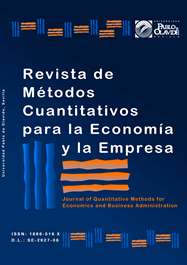Forecasting the Colombian Monthly Inflation One Step Ahead: A "Bottom to Top" Approach
DOI:
https://doi.org/10.46661/revmetodoscuanteconempresa.2688Keywords:
IPC, inflación, pronósticos, de abajo hacia arriba, Colombia, CPI, inflation, forecasts, "bottom to top"Abstract
The hierarchical structure of the Colombian Consumer Price Index (CPI) makes possible to calculate inflation as a linear combination of its subcomponents. We use SARIMA models to forecast each component of CPI and construct an forecast of inflation using a lineal combination of the forecasts of these components, i.e. a "bottom to top" approach. In this paper, we asses the out-of-sample performance of the one-step ahead forecast of 12 "bottom to top" methodologies. These methods are compared with an aggregate forecast using a SARIMA model. Our results show that a "bottom to top" method to forecast inflation outperforms an aggregate approach for the case of monthly inflation in Colombia.
Downloads
References
Benalal, N.; del Hoyo, J. L.; Roma, M.; Landau, B. & Skudelny, F. (2004). "To aggregate or not to aggregate? Euro Area Inflation Forecasting". ECB Working Paper No. 374. European Central Bank.
Cuitiño, F.; Ganón, E.; Tiscordio, I. & Vicente, L. (2010). "Modelos univariados de series de tiempo para predecir la inflación a corto plazo". Documento de trabajo No. 008-2010. Banco Central de Uruguay.
Demers, F. & De Champlain, A. (2005). "Forecasting Core Inflation in Canada: Should We Forecast the Aggregate or the Components?". Working paper 2005-44. Bank of Canada.
Diebold, F. X. & Mariano, R. S. (1995). "Comparing predictive accuracy", Journal of Business & Economic Statistics, 13, 253–265.
Dornbusch, R. (1976). "Expectations and exchange rate dynamics", Journal of Political Economy, 84(6), 1161–1176.
Espasa, A., Senra, E. & Albacete, R. (2002). "Forecasting inflation in the European Monetary Union: A disaggregated approach by countries and by sectors", The European Journal of Finance, 8(4), 402–421.
Firth, M. (1979). "The Relationship Between Stock Market Returns and Rates of Inflation", The Journal of Finance, 34(3), 743–749.
Fritzer, F., Moser, G. & Scharler, J. (2002). "Forecasting Austrian HCPI and its Components using VAR and ARIMA Models". Working Paper 73, Oesterreichische Nationalbank.
Grunfeld, Y. & Griliches, Z. (1960). "Is aggregation necessarily bad?", The Review of Economics and Statistics, 42(1), 1–13.
Harvey, S. K. & Cushing, M. J. (2014). "Does Using Disaggregate Components Help in Producing Better Forecasts for Aggregate Inflation?", Journal of Economics and Development Studies, 2(2), 527–546.
Hendry, D. F. & Clements, M. P. (2004). "Pooling of forecasts", Econometrics Journal, 5, 1–31.
Hendry, D. F. & Hubrich, K. (2011). "Combining disaggregate forecasts or combining disaggregate information to forecast an aggregate", Journal of Business & Economic Statistics, 29(2), 216–227.
Hubrich, K. (2005). "Forecasting euro area inflation: Does aggregating forecasts by HICP component improve forecast accuracy?", International Journal of Forecasting, 21(1), 119–136.
Hyndman, R. J., Khandakar , Y. (2008). "Automatic Time Series Forecasting: The forecast Package for R", Journal of Statistical Software, 27(3), 1-22.
Miller, K. D., Jeffrey, F. J. & Mandelker, G. (1976). "The 'Fisher effect' for risky assets: An empirical investigation", The Journal of Finance, 31(2), 447–458.
Nelson, C. R. (1976). "Inflation And Rates Of Return On Common Stocks", The Journal of Finance, 31(2), 471–483.
Pino, G., Tena, J. D., & Espasa, A. (2013). "Forecasting disaggregates by sectors and regions: the case of inflation in the euro area and Spain". Working Paper 13-08. Statistics and Econometrics Series 07. Universidad Carlos III de Madrid.
R Core Team (2016). R: A language and environment for statistical computing. R Foundation for Statistical Computing, Viena.
Solnik, B. (1983). "The relation between stock prices and inflationary expectations: The international evidence", The Journal of Finance, 38(1), 35–48.
Svensson, L. E. O. (1997). "Inflation forecast targeting: Implementing and monitoring inflation targets", European Economic Review, 41(6), 1111–1146.
Theil, H. (1954). Linear aggregation of economic relations. North-Holland Pub. Co.
Downloads
Published
How to Cite
Issue
Section
License
Copyright (c) 2017 Journal of Quantitative Methods for Economics and Business Administration

This work is licensed under a Creative Commons Attribution-ShareAlike 4.0 International License.
Submission of manuscripts implies that the work described has not been published before (except in the form of an abstract or as part of thesis), that it is not under consideration for publication elsewhere and that, in case of acceptance, the authors agree to automatic transfer of the copyright to the Journal for its publication and dissemination. Authors retain the authors' right to use and share the article according to a personal or instutional use or scholarly sharing purposes; in addition, they retain patent, trademark and other intellectual property rights (including research data).
All the articles are published in the Journal under the Creative Commons license CC-BY-SA (Attribution-ShareAlike). It is allowed a commercial use of the work (always including the author attribution) and other derivative works, which must be released under the same license as the original work.
Up to Volume 21, this Journal has been licensing the articles under the Creative Commons license CC-BY-SA 3.0 ES. Starting from Volume 22, the Creative Commons license CC-BY-SA 4.0 is used.










